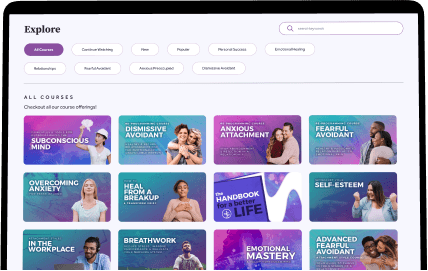Understanding your attachment style can provide valuable insights into your love life dynamics and help you foster healthier connections.
In this blog post, we will explore the different attachment styles and their impact on romantic relationships, empowering you to navigate the complexities of love with self-awareness and compassion.
But firstly, let's look at attachment styles in the first place.
What are Attachment Styles?
Attachment theory was developed in the 1950s by John Bowlby and later expanded upon by Mary Ainsworth. The theory is based on the belief that attachment styles, which are formed in early childhood, based on interactions and experiences with parents and/or caregivers, impacts how we see and believe in love and relationships.
As such, there are four types of attachment styles: secure attached (SA), anxious preoccupied (AP) -- also known as anxious attached (AA) -- , dismissive avoidant (DA) -- which are also called “disorganized or disoriented” attachment styles -- and fearful avoidant (FA).
Each attachment style is different, and therefore, impacts your love life in different ways. Let's look at each one and how it works.

The Four Attachment Styles in Relationships
Securely Attached Individuals in Relationships
Individuals with a secure attachment style tend to have fulfilling and stable relationships. They have a positive view of themselves and others, are comfortable with intimacy and autonomy, and effectively communicate their needs.
Securely attached individuals form strong emotional bonds, experience trust, and navigate conflicts with openness and understanding. They create a safe space for their partners and foster mutual growth and support.
The ideal environment for a secure attachment style includes:
- Open lines of communication about feelings
- A willingness to share experiences and deeply connect
- Transparency and honesty in the relationship
- Generous with personal boundaries
- Happy to be vulnerable
You can cultivate a secure attachment style by working on changing your habits and patterns. It's an achieveable goal that anyone can do.
Anxious Preoccupied Individuals in Relationships
Those with an anxious preoccupied attachment style often crave intimacy and reassurance but fear abandonment. They seek constant validation, worry about their partner's feelings, and are prone to jealousy and possessiveness. They may become overly dependent and struggle with self-esteem.
These actions lead them to become "clingy" in their relationships, latching onto their partners so they can avoid rejection. They even self-sacrifice their own needs and boundaries to keep their partners happy, and develop relationship anxiety.
Anxious preoccupied individuals need special environments to find happiness in relationships, including:
- Open communication
- Understanding and acknowledging their feelings
- Positive reinforcement and words of affirmation
- Deep emotional connections
- Constant reassurance about the state of the relationship
Anxiously attached individuals benefit from developing self-worth, managing anxiety, and improving communication skills to express needs effectively and alleviate insecurities.
Dismissive Avoidant in Relationships
Individuals with a dismissive avoidant attachment style prioritize independence and fear emotional intimacy. They value self-reliance, struggle to trust others, and may avoid commitment. Dismissives may distance themselves emotionally, struggle with vulnerability, and have difficulty expressing their emotions.
Communication is a big factor for dismissive avoidants if they want to build healthy relationships. That comes from their conscious or subconscious belief that they could rely only on themselves.
But if they focus on developing a relationship based on:
- Consistency and communication
- Kindness and support
- Space, freedom, and autonomy
The dismissive avoidant can still be a great partner. They need to address their self-awareness, challenge fears of intimacy, and gradually allow themselves to be vulnerable, which can help them form healthier and more fulfilling relationships.
Fearful Avoidant in Relationships
Fearfil avoidant attachment styles combine anxious and avoidant tendencies. Those with a fearful avoidant style often have inconsistent behaviors, experiencing both a fear of abandonment and a fear of intimacy. They may struggle with emotional regulation and have difficulty maintaining stable and healthy relationships.
However, despite this, fearful avoidants do show up in relationships in many ways by being incredibly passionate, empathetic, and attuned to others’ needs. They can also adopt caregiving roles and are generous by nature.
But this originates from them when:
- Feel comfortable expressing their feelings
- Trust their partner openly and have a highly transparent relationship
- Can be vulnerable, which is received well and positively reinforced
- Go past any of their codependency tendencies and focus on themselves
- Have time for themselves to grow and learn
However, for some fearful avoidants, seeking professional support can help them explore and heal underlying traumas or unresolved issues that contribute to their attachment style.
Learn About Your Attachment Style
Your attachment style significantly impacts your love life, shaping how you approach relationships, communicate, and navigate emotional intimacy. By knowing your attachment style via our free quiz — whether it is secure, anxious preoccupied, dismisive avoidant, or fearful avoidant — you can gain self-awareness and develop strategies to foster healthier connections.
Embrace personal growth, seek support when needed, and cultivate self-compassion as you navigate the complexities of love, leading to more fulfilling and nurturing relationships.
The best way to start learning and healing your attachment style is by taking our Emotional Mastery & Belief Reprogramming course.
Share this Article
Let's stay connected!
Get personal development tips, recommendations, and exciting news every week.
Become a Member
An All-Access Pass gives you even more savings as well as all the relationship and emotional support you need for life.

Top Articles
31 AUG 2023
8 Ways to Heal a Fearful Avoidant Attachment Style
Healing your fearful avoidant attachment style is possible with 8 simple steps, including communicating your needs and releasing unrealistic expectations.
27 OCT 2023
Best Strategies for Intimacy & Sex with Dismissive Avoidants
Learn about dismissive avoidants, sex and how you can bring your relationship closer together in this extensive guide.
13 JUN 2024
Signs Your Avoidant Partner Loves You
Are you dating an avoidant but don’t if they love you? Here are the clear-cut signs that an avoidant loves you.